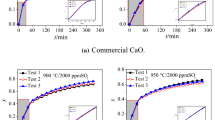Abstract
Oxidation within the system CCl4/CH4/O2/N2 is studied at atmospheric pressure in a tubular flow reactor to investigate the influence of reaction temperature and chlorine content on chlorinated waste combustion and find incineration process optimization methods for pollution control. The reaction temperature varies from 700°C to 1000°C and the CCl4/CH4 (or Cl/H) mole ratio of the inlet mixture varies from 0.21 to 0.84. Products profiles are measured with FT-IR. It is shown that at the same initial CCl4 concentration and reaction temperature adding CH4 favors CCl4 destruction and CO2 formation. But the destruction and removal efficiency (DRE) of CH4 decreases with lower Cl/H and higher concentrations of toxic products of incomplete combustion such as COCl2 and CH3Cl are formed at the same time. The chlorine in the system favors CH4 decomposition, but it also inhibits further oxidation of CO. Higher temperature assists in both CCl4 destruction and CH4 conversion, and the concentration of toxic combustion intermediates is reduced. Increasing the temperature is the most effective way to enhance CCl4 oxidation. The CO2 concentration increases with temperature. A CO concentration peak is observed around 800°C: with a certain Cl/H, the CO concentration first increases with temperature and then declines. The effect of increasing CH4 concentration on CCl4 destruction becomes mild above 900°C. Rather, it enhances the interaction between chlorine and carbonaceous radicals, which leads to higher concentration of toxic products.
Similar content being viewed by others
References
Oppelt E T. Incineration of hazardous waste: A critical review. J Air Pollut Contr Assoc, 1987, 37: 556–586
Saxena S C, Jotshi C K. Management and combustion of hazardous wastes. Progr Energ Combust Sci, 1996, 22: 401–425
Santoleri J J. Chlorinated hydrocarbon waste disposal and recovery systems. Chem Eng Progr, 1973, 69: 68–74
Gupta A K. Combustion of chlorinated hydrocarbons. Chem Eng Comm, 1986, 41: 1–21
LI S Y, Bie R S, Wang H. Experimental study on the emission and removal of HCl from incineration of chlorinated waste water in fluidized bed. Proc CSEE (in Chinese), 2006, 26: 40–44
Bose D, Senkan S M. On the combustion of chlorinated hydrocarbons. Combust Sci Tech, 1983, 35: 187–202
Ho W P, Barat R B, Bozzelli J W. Thermal reactions of CH2Cl2 in H2/O2 mixtures: implications for chlorine inhibition of CO conversion to CO2. Combust Flame, 1992, 88: 265–295
Koshland C P, Fisher E M, Lucas D. Thermal destruction of some chlorinated C1 and C2 hydrocarbons. Combust Sci Tech, 1992, 82: 49–65
Sorbo N W, Chang D P Y. Observations of chlorinated hydrocarbon droplet gasification. Combust Sci Tech, 1992, 85: 419–435
Lou J C, Chang Y S. Thermal oxidation of chloroform. Combust Flame, 1997, 109: 188–197
Sgro L A, Koshland C P, Lucas D, et al. Postflame reaction chemistry of dichloromethane: Variations of equivalence ratio and temperature. Combust Flame, 2000, 20: 492–503
Wu Y P, Lin Y F. The oxidation of trichloroethene with methane: experiment and kinetic modeling. Combust Flame, 2004, 137: 376–402
Cundy V, Acharya S, Sterling A M, et al. Rotary kiln incineration. III: An indepth study-kiln exit/afterburner/stack train and kiln exit pattern factor measurements during liquid CCl4 processing. J Air Pollut Control Assoc, 1989, 39: 944–952
Shilov A E, Sabirova R D. Mechanism of the primary thermal breakdown of chlorine derivatives of methane. I. Breakdown of carbon tetrachloride. Zh Fiz Khim, 1959, 33: 1365
Taylor P H, Dellinger B. Thermal degradation characteristics of chloromethane mixtures. Environ Sci Tech, 1988, 22: 438–447
Taylor P H, Dellinger B, Tirey D A. Oxidative pyrolysis of CH2Cl2, CHCl3, and CCl4-I: incineration implications. Int J Chem Kinet, 1991, 23: 1051–1074
Morse J S, Cundy V A, Lester T W. Profiles of laminar carbon tetrachloride/methane/air flames Combust Sci Tech, 1989, 66: 59–73
Xieqi M, Cicek B, Senkan S M. Chemical structures of fuel-rich and fuel-lean flames of CCl4/CH4 mixtures. Combust Flame, 1993, 94: 131–145
Leylegian J C, Law C K, Wang H. Laminar flame speeds and oxidation kinetics of tetrachloromethane. Symp Combust Proc, 1998, 27: 529–536
Roesler J R, Yetter R A, Dryer F L. Detailed kinetic modelling of moist CO oxidation inhibited by trace quantities of HCl. Combust Sci Tech, 1992, 85: 1–22
Wang B, Chi Y, Yan J H, et al. Experimental study on CO oxidation inhibited by chlorine. Proc CSEE, 2009, 29: 58–62
Wei X L, Wang Y, Liu D F. Influence of HCl on CO and NO emissions in combustion. Fuel, 2009, 88: 1998–2003
Lyon R K. The NH3-NO-O2 reaction. Int J Chem Kinet, 1976, 8: 315–318
Lyon R K, Benn D. Kinetics of the NO-NH3-O2 reaction. Symp Combust Proc, 1978, 17:601–610
Lyon R K. The existence of second threshold for combustion and its implications to incineration. Symp Combust Proc, 1990, 23: 903–908
Ho W P, Yu Q R, Bozzelli W. Kinetic study on pyrolysis and oxidation of CH3Cl in Ar/H2/O2 mixtures. Combust Sci Tech, 1992, 85: 23–63
Author information
Authors and Affiliations
Corresponding author
Rights and permissions
About this article
Cite this article
Wang, B., Chi, Y., Yan, J. et al. Experimental study on CCl4/CH4/O2/N2 oxidation. Sci. China Technol. Sci. 53, 1016–1022 (2010). https://doi.org/10.1007/s11431-010-0002-y
Received:
Accepted:
Published:
Issue Date:
DOI: https://doi.org/10.1007/s11431-010-0002-y



